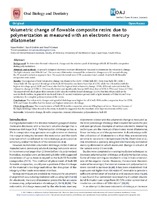| dc.contributor.author | Mulder, Riaan | |
| dc.contributor.author | Grobler, Sias Renier | |
| dc.contributor.author | Osman, Yusuf Ismail | |
| dc.date.accessioned | 2014-08-05T20:26:06Z | |
| dc.date.available | 2014-08-05T20:26:06Z | |
| dc.date.issued | 2013 | |
| dc.identifier.citation | Mulder, R., Grobler, S.R. & Osman, Y.I. (2013). Volumetric change of flowable composite resins due to polymerization as measured with an electronic mercury dilatometer. Oral Biology and Dentistry. 1:1 | en_US |
| dc.identifier.issn | 2053-5775 | |
| dc.identifier.uri | http://hdl.handle.net/10566/1152 | |
| dc.description.abstract | BACKGROUND: To determine the total volumetric change and the relative speed of shrinkage of bulk fill flowable composites
during polymerization.
MATERIALS AND METHODS: A specially designed electronic mercury dilatometer was used to determine the volumetric change.
The light intensity was 500mW/cm2. The mercury dilatometer measured the volumetric change every 0.5 seconds during
the 35 second irradiation exposure time. The materials tested were Z250 as standard and control. Four bulk fill flowable
composites were tested.
RESULTS: The sequence of total volumetric change was found to be: Z250 < Filtek bulk fill < Xtra-Base bulk fill < SDR <
Venus bulk fill. The speed of shrinkage of the bulk fill flowables was faster than that of Z250, while the 2 flowables with the
highest shrinkage speed (SDR and Venus) also had the highest total volumetric change. Of the different materials tested the
volumetric change of Z250 (1.13%) was the lowest and significantly less (p<0.05) than that of SDR (1.55%) and Venus (1.72%).
The material with the highest filler content (Z250) also showed the lowest shrinkage (1.13%) but this effect could not be
seen in the flowables. In general, it was found that a 35 second irradiation period (with a light intensity of 500mW/cm2) was
satisfactory for complete polymerization of the resins.
CONCLUSIONS: The volumetric changes and speed of shrinkage were higher for all 4 bulk fill flowable composites than for Z250.
SDR and Venus flowables had the fastest and highest volumetric shrinkage.
Clinical significance: The manufacturers of bulk fill flowable composites advocate filling layers of 4mm. However, because of
the high shrinkage values found in this study it should be suggested that the standard 2mm layer increments still be used. | en_US |
| dc.description.sponsorship | It was partly supported by the IADR and the C. H. Pameijer Fellowship 2012. | en_US |
| dc.language.iso | en | en_US |
| dc.publisher | Herbert Publications Ltd. | en_US |
| dc.rights | © 2013 Mulder et al; licensee Herbert Publications Ltd. This is an Open Access article distributed under the terms of the Creative Commons Attribution License (http://creativecommons.org/licenses/by/3.0), which permits unrestricted use, distribution, and reproduction in any medium, provided the original work is properly cited. | |
| dc.source.uri | http://dx.doi.org/10.7243/2053-5775-1-1 | |
| dc.subject | Volumetric change | en_US |
| dc.subject | Flowable composites | en_US |
| dc.subject | Mercury dilatometer | en_US |
| dc.subject | Bulk fill | en_US |
| dc.subject | Flowable composites | |
| dc.title | Volumetric change of flowable composite resins due to polymerization as measured with an electronic mercury dilatometer | en_US |
| dc.type | Article | en_US |
| dc.privacy.showsubmitter | false | |
| dc.status.ispeerreviewed | true | |
| dc.description.accreditation | Web of Science | en_US |

